Casa do Povo – Lexicon for an Art Institution
July 15, 2025
Editorial, São Paulo, Interdependence
July 15, 2025
Editorial, São Paulo, Interdependence
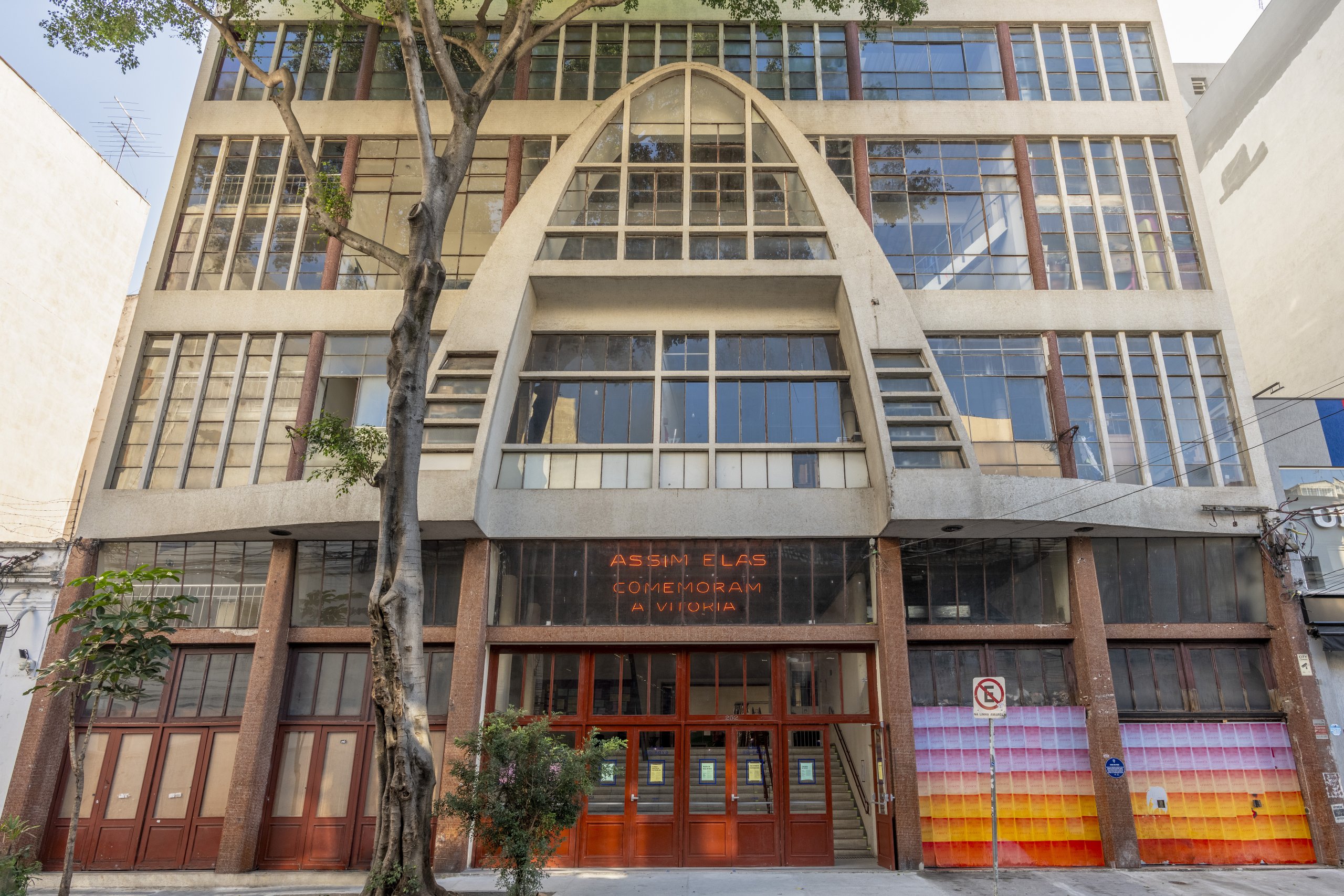
The first time I entered Casa do Povo (“The People’s House”) was in 2011. As an editor of a Jewish magazine at the time, I wanted to interview figures from the former Ashkenazi quarter in downtown São Paulo, Brazil. I had scheduled an interview with Hugueta Sendacz, the eighty-three-year-old (now ninety-eight-year-old) leader of a Yiddish choir called Coral Tradição. Its repertoire is made of lullabies, protest music, and love songs. It gathered mostly elderly women to sing on Monday nights, in Yiddish, for no one—and with little perspective of public presentations.
Walking up the generous staircase in the entrance of the building, each floor seemingly became larger than the previous one, with high ceilings, wooden floors, and big windows. But the sixty-year-old building was in very bad condition. Only the ground floor was effectively functioning. Pigeons had come to dominate the terrace, and bats had taken up residence in the underground theater.
Hugueta told me the story of the institution and its headquarters: an impressive five-story modern building located in what has become a Bolivian and Korean neighborhood. She remembered when Casa do Povo was first announced in 1946, in the aftermath of the end of the Second World War. She was in her early twenties. The São Paulo leftist Jewish community—mostly communist—wanted to pay an homage to the victims of the Shoah. They thought the best way to remember the dead was to take care of the living.
As a young curator, I was fascinated. Strolling through Casa do Povo and reflecting on its history, I immediately started to imagine its potential. Since it functioned as an association, I became a member, and a year later I was elected to the association board. Together with Hugueta and many others, I started to rebuild the institution: bringing new members in, updating the artistic and political project, connecting it to the local art scene and social movements, fundraising, structuring governance, and building up a team to work there. As Casa do Povo was getting back on its feet, I left the board to become part of the team myself.
When I first began working there, I started by looking both into the history of the institution as well as the needs of the cultural scene in São Paulo. Institutions were generally quite weak in São Paulo back then, with big museums competing for the same resources as autonomous art spaces. Different from the Global North where small-scale institutions grow “in between” bigger institutions, in São Paulo there was no “in between.” The challenge, however, was to build the institution we wanted regardless of its size. We started to ask ourselves: what if an art institution wasn’t stuck to a fixed grid (exhibitions, seasons, workshops, etc.)? What if hours could adapt to each project? What if we could decentralize decision-making to a point where the institution could host different worlds (and not swallow the entire world)? What kind of economy can work for that? Who should we depend on? On what forms of governance should we draw?
What follows are fragments of a larger lexicon in process Casa do Povo: Modos de Fazer, Ana Druwe, Benjamin Seroussi (org.), Publication Studio São Paulo, Casa do Povo, São Paulo, 2025 that gives names and descriptions to some of the tools we used, some of the compasses that oriented us, and some of the horizons that we looked for as we were collectively rebuilding the institution over the past decade.
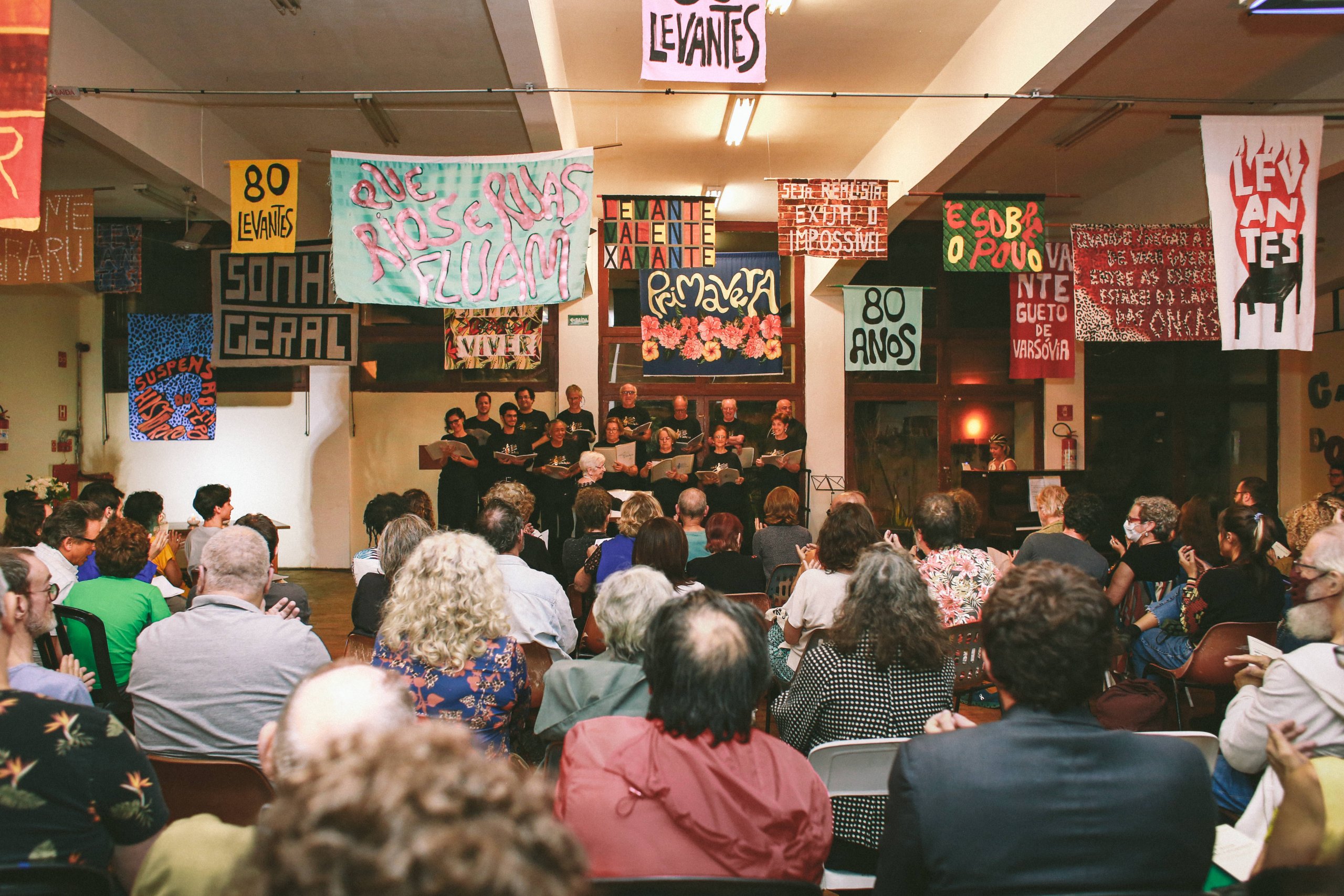
Choir
Singing together was one of Casa do Povo’s original forms of organization. From its very beginning in 1946, the plan was to host a theater, a newspaper, a school, and a choir. The Scheiffer Choir began in 1935, years before Casa do Povo opened, and found its home in Casa do Povo as soon as the building was inaugurated in 1953. Decades later, when the institution entered into decline in the 1980s, it was another choir, Coral Tradição, that kept its doors open.
When people are in diaspora, they carry their stories, their languages, their books, and their songs. Music crosses generations and becomes an archive, one that can always be reactivated by those still moved by its melodies. The meaning of the words may fade out into a forgotten language, but two or more people who know the same song can form a choir, and a choir can be the basis for reinventing lost worlds.
In 2023, Yael Bartana brought together Ilu Oba de Min, an Afro-Brazilian percussion group led by women, and Coral Tradição. The work called Mir Zaynen Do [We Are Here] was recorded in the ruined theater in the basement of Casa do Povo. It functions as a baton passing from one diaspora to another—the institution itself being the baton.
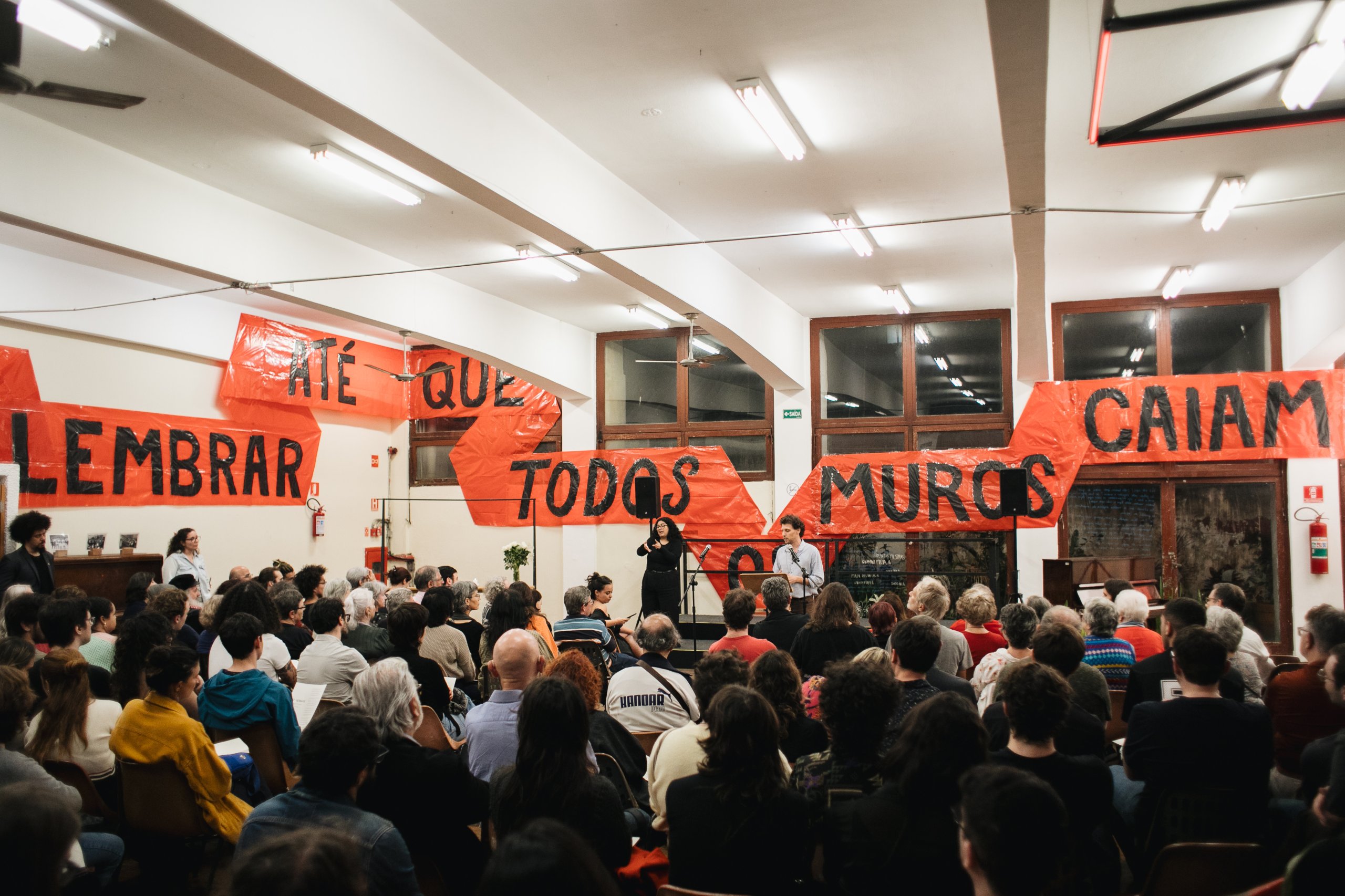
Living Monument
Those who founded Casa do Povo had to bring together two very different needs: to honor the Jews murdered during the war, and to bring together the neighborhood’s antifascist Jewish associations. The first could be addressed with a memorial (to store memory) or a commemorative sculpture (to visit once a year), and the second with a community center. Casa do Povo is the unexpected encounter of these two needs. It is an empty space where remembering is a constant form of renewed action.
The way we remember the past is something that constantly changes according to the needs of the present. As such, Casa do Povo’s space is adapted on a daily basis. We call Casa do Povo a “living monument,” an “anti-monument,” or a “monument of the defeated crying for victory.” Its ruined (or unfinished) condition points to a path that is kept open, complex, and unsolved. Over time, bottom up, away from power, Casa do Povo has become a refuge for the stories that don’t fit the official narrative. Casa do Povo is now the home of many different archives, from social movements to artistic ones. Parallel to this, the space remains flexible: there are no fixed uses for each space (exhibition halls, workshops, classrooms, etc.). On the contrary, spaces are held open for the unpredictable: a meeting, a rehearsal, a talk, a performance…
Sites of Memory
In Les Lieux de Mémoires, Pierre Nora describes what he calls a “site of memory” as a place, or symbol, that carries collective memories. Les Lieux de mémoire, Pierre Nora (under the direction of), Gallimard, Paris, 3 tomes : t. 1 La République (1 vol., 1984), t. 2 La Nation (3 vol., 1986), t. 3 Les France (3 vol., 1992), Casa do Povo was imagined as exactly that, and does not monumentalize memory; instead, it is constantly activated through daily collective practices grounded in specific values. When we commemorate the 1943 uprising of the Warsaw Ghetto, for instance, we invite lecturers to reflect on the uprisings that need to take place today. This historical commitment to living memory led Casa do Povo to be a stronghold of resistance during Brazil’s dictatorship, when it hosted important plays by Augusto Boal and Gianfrancesco Guarnieiri, dodging censorship. Today, the institution still functions as a hub for social movements and dissident artistic practices.
In a city where erasing the past has long been a political project, the existence of this building is an act of resistance—as is its openness to diversity. At Casa do Povo, remembering the dead means caring for the living. In such a dynamic, remembrance has become a way of forging alliances, bringing the history of one catastrophe into dialogue with those of other peoples. That’s why, at Casa do Povo, “never again” means “never again” not just for the Jewish people, but also for Black communities, for the Palestinian people, for Indigenous nations. As the list goes on we tend to feel powerless, but we still believe that telling our story means making space for others. People deposit their memories here, even without prior ties to the space. These stories remain alive and connected, both to each other and to the bodies that carry them, dreaming together of a time yet to come.
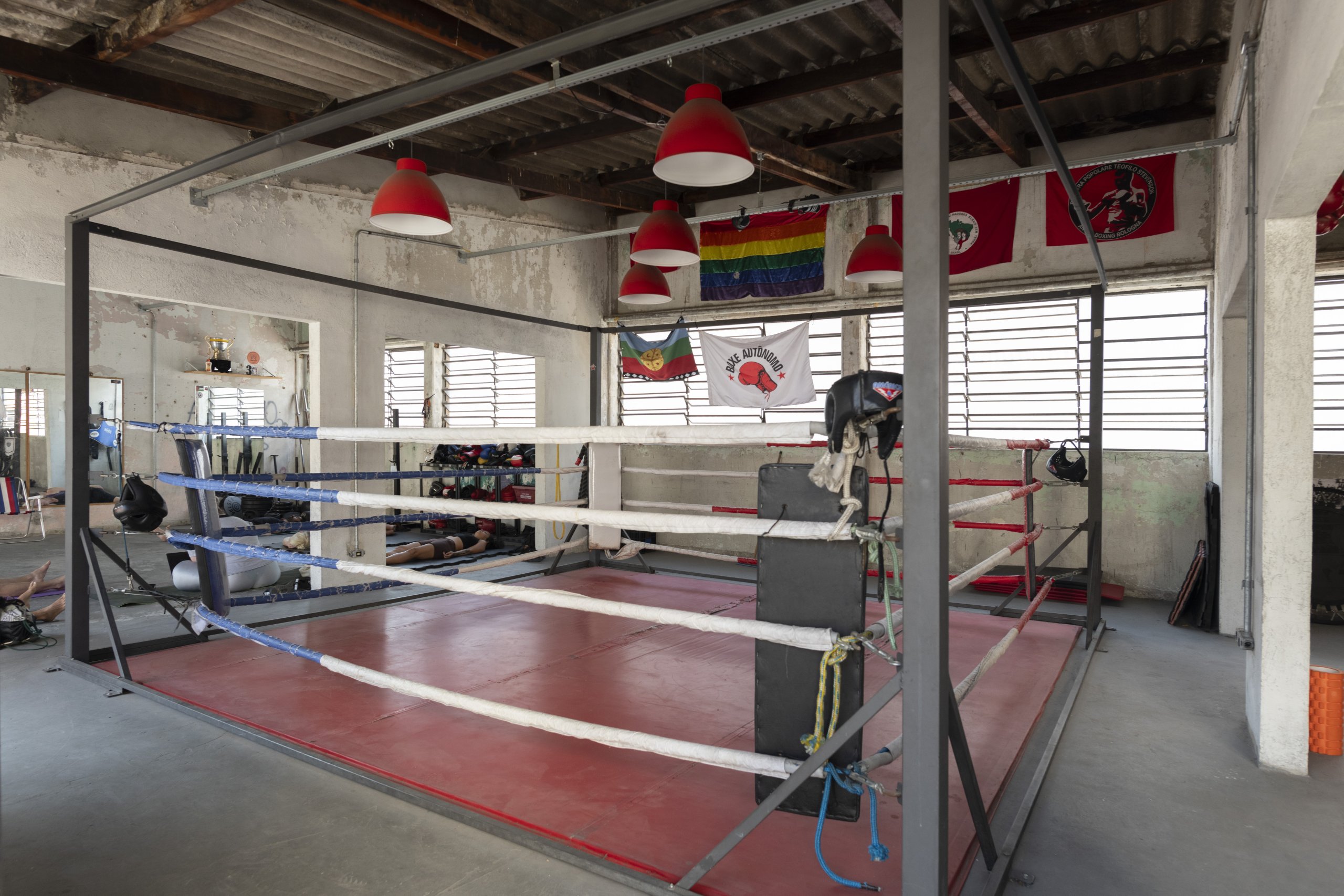
Key
A key is a symbol of radical trust. We give the keys to our homes to only a very few people. Keys also unlock memories. Jews who were expelled from Spain in the fifteenth century kept their house keys for generations. Palestinians who were forced to leave their homes in 1948 did the same. These are keys whose actual locks no longer exist, but they remain anchors to a past that is constantly being reinvented.
We give the key to our front door to all groups and partners. For groups, this allows them to work autonomously. They even decide how many copies to make and how to use them. For partners, this deepens a bond with a place they’ve known. But for Casa do Povo, it’s a way to decentralize our operation and build an institution grounded in radical trust.
House
At first glance, it seems unlikely that a people (povo) can fit into a house (casa). But it’s precisely in the tension between the domestic scale of a house and the vastness of a people that the possibility of a different kind of institution emerges: an institution of the commons.
People’s House, Casa del Pueblo, Volkshuis, Folkets Hus, Beit Ha’am, Casa del Popolo, Maison du Peuple… This idea isn’t new. Similar structures have emerged around the world over the past centuries in Brussels, Rome, Zurich, Stockholm, Ein Harod, and elsewhere. Many were destroyed and many were abandoned. Some remain as tokens of a lost international. These institutions were not necessarily connected to each other, but they all stem from a similar political background. The very first of these were built for or by workers in the nineteenth century. When leftist parties came to power, these types of institutions sometimes even became created as part of public policies. In the past decades, they have often become anachronic. Casa do Povo works to maintain and renew this tradition.
Diaspora
Diaspora is not exile. While exile is an absence, diaspora is a territory. This territory can be shaped by a language, a shared experience, a religious practice, a body of knowledge, or a thousand other ways of making community. In diaspora, a people can exist without a state or an army. Diaspora is not possessive. It doesn’t prevent other affiliations. On the contrary, diasporic identity is by definition incomplete and heterogeneous. It knows no purity. It calls for otherness. It is restless, unstable. It doesn’t subtract. It only adds. It always runs the risk of losing itself in the other.
As a Jewish institution, Casa do Povo is diasporic. Its roots are planted in the air, and its people in a constant becoming. And because it is diasporic, it must always be something else as well. This is the basis of our understanding that an institution should be porous and host minorized and racialized groups. Taking the risk of getting lost in otherness is the only way to find ourselves.
Among the twenty collectives that inhabit Casa do Povo today are: Parquinho Gráfico, a publication studio focused on queer design; MEXA, a performance group created to challenge state gender-based violence; Letigima Defesa, a theater group that focuses on issues related to the African diaspora; a Korean choir; a Bolivian seamstress collective; a boxing academy… All of these groups have the key to Casa do Povo.
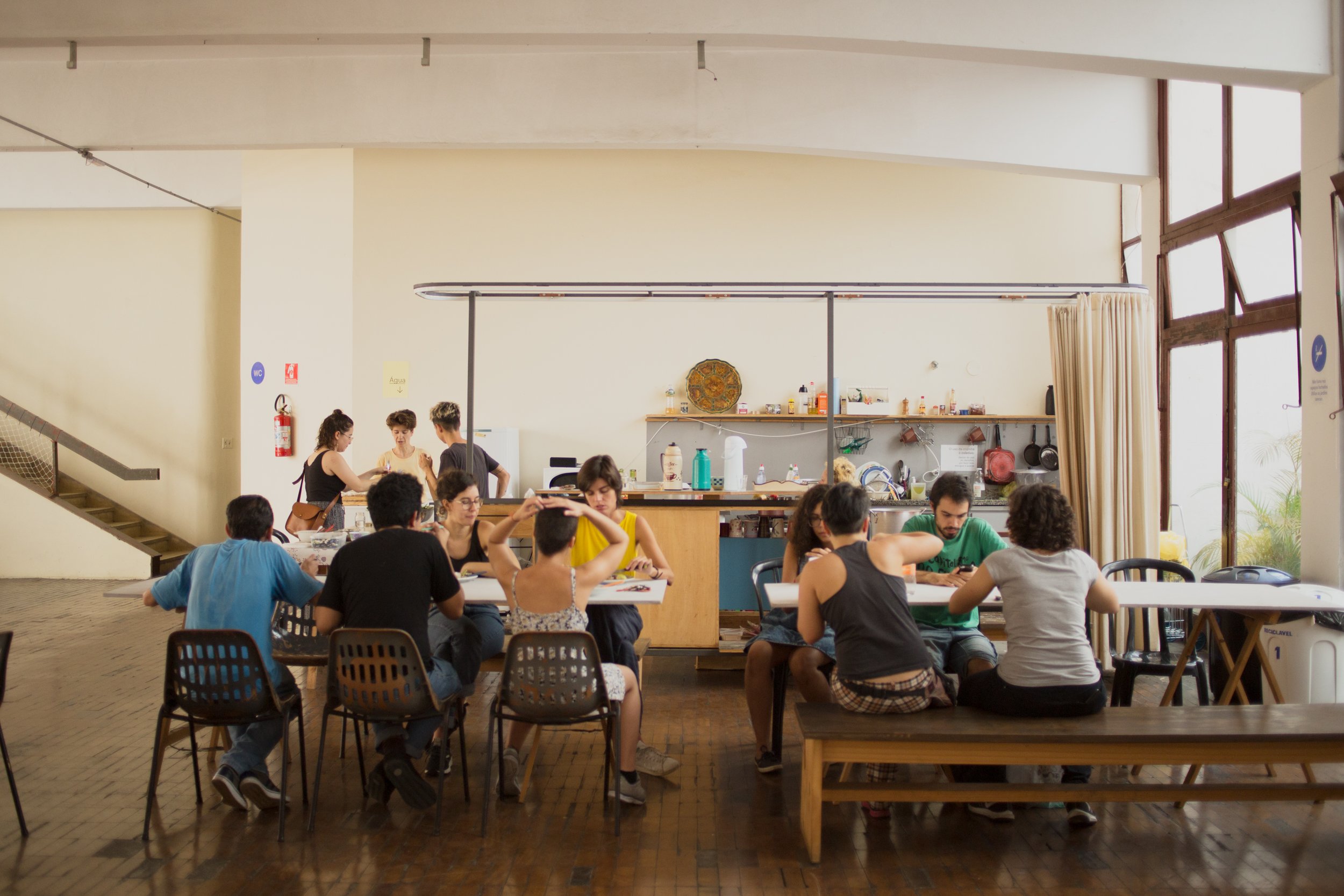
Hospitality
If you walk into an arts institution looking for a café but all you find is a kitchen, a thermos, a coffee filter, and ground coffee, you make your own coffee. If this happens every time you visit, suddenly, you might find yourself brewing coffee not just for yourself, but for the staff, the artists, and the visitors. Little by little, you become part of the community.
Hospitality is about blurring boundaries between inside and outside, professional and amateur, staff and visitor. Casa do Povo doesn’t have an information desk. Visitors have to accept getting a little lost in order to find their way. But good hosts make guests feel so at home that they can become hosts themselves. Roles are swapped daily. Tables are rearranged in different ways. Programming is created by those who inhabit the space. Every floor has a broom within reach. There are few instructions. Agreements are flexible.
We have been working in the past decade to develop a way to decentralize decision making within the institution. Today, groups elect representatives that sit with members of the team to discuss how the space should be used, what new groups can join, and how to share resources, among other issues.
Deep Listening
The neighborhood doesn’t wait for you at the corner of a street; it’s something collective, diffuse, and under continuous construction. To be in touch with a neighborhood is to understand its singularities and engage—not without friction—its diversity: people, groups, businesses, churches, associations.
Many institutions develop mediation programs to “dialogue” with their surroundings. These programs usually assume that the institution and the neighborhood are separate and static entities. And because they are initiatives that stem from inside institutions, they often create one-way relationships, where the institution explains what it does to the people outside. This comes from the fact that many institutions think people do not visit because they are unaware of what the institution is doing. But the truth is, people don’t come because they have no interest in what institutions do.
Active listening tries to turn this dynamic upside down. It seeks a two-way relationship where the institution genuinely hears what people want and tries to respond to it from its own identity. For Casa do Povo, this has meant establishing food distribution and food education programs, solidarity groups for migrant women, space for local initiatives to rehearse, and information desks to get access to basic civil rights. The institution and the community reshape one another.
Space
Spaces need to be listened to. We imagine the members of the commission that built Casa do Povo, gathered in the 1940s in conversation with a group of architects—among them Ernest Mange, fresh from an internship with Le Corbusier—laying out their ambitious dreams: a reading room, a sports hall, a school, a monument, a theater… The architects chose what Le Corbusier called a “free plan”: generous, open floors stacked one over another; spaces that could become anything.
When reactivating Casa do Povo, we could have imposed a program on the building: a café on the ground floor, studios on the first floor, exhibitions on the second floor, residences on the rooftop. Instead, we took another path: we embraced the free plan as a program without a program; an open invitation that adapts to use. As visitors climb the stairs, the building becomes more open (wider and wider) and more intimate (away from the street and the noise).
In 2018, to enable this flexible use of the space, we commissioned Grupo Inteiro, an artistic and architecture collective, a series of furniture that could easily be moved around: shelves that are molded on the building’s architecture, exhibition displays that can be stored, a mobile structure that functions as a small office, among other elements on wheels.
All of the building’s spaces are shared. This takes the complex coordination of each group, space, and agenda, but it allows us to host many more initiatives than we could if we would give a room to each one. Between one activity and another, the floors often remain open. In these pauses, visitors can see beyond what we do—what is possible—and feel what they might do—what is potential.
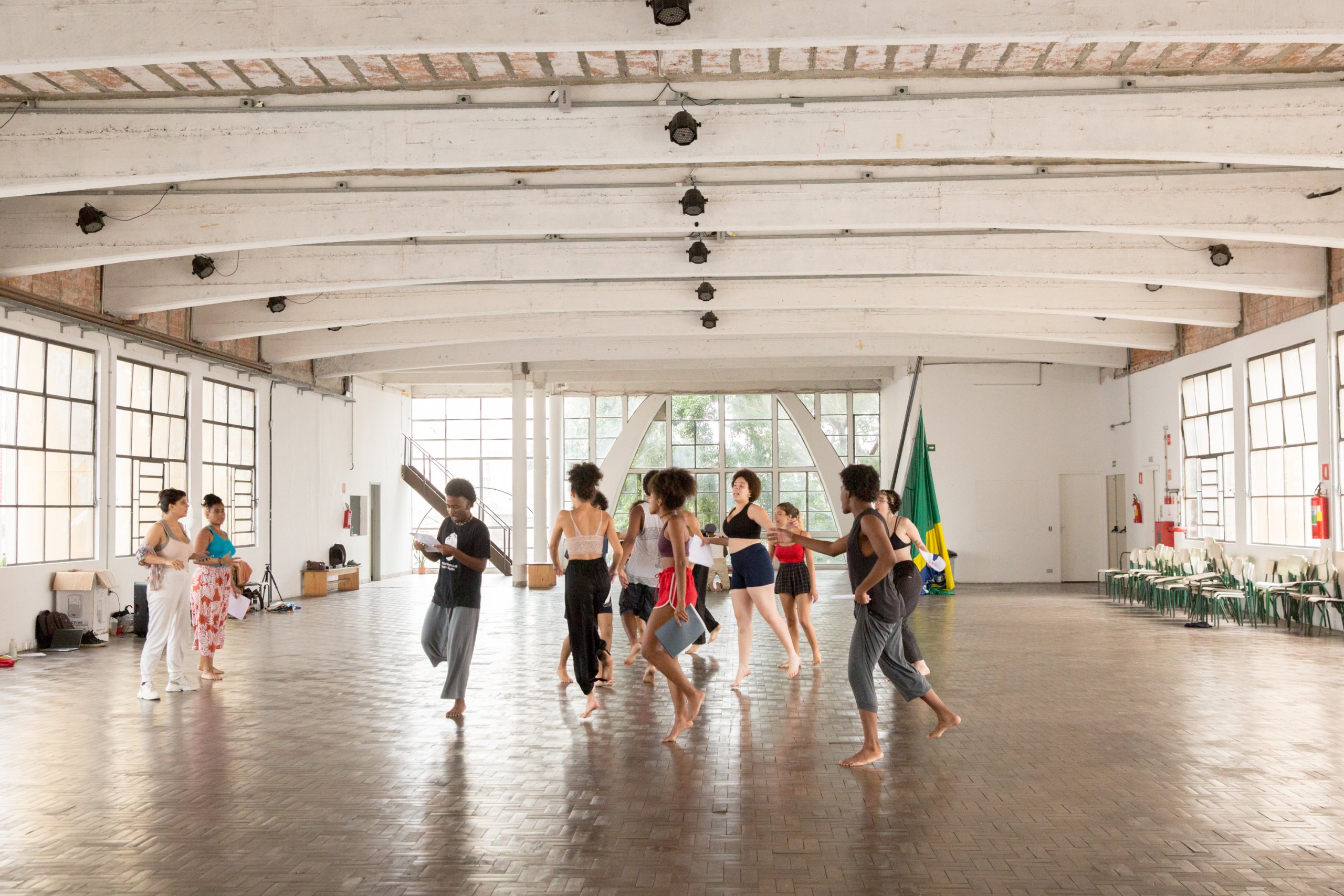
Art (and Culture)
Art has the power to generate twists, noise, friction. It’s with this disruptive potential in mind that Jean-Luc Godard once said: “Culture is the rule; art is the exception.” (Je vous Salue, Sarajevo, 1993). If culture organizes, art disorganizes. At Casa do Povo, art and culture walk hand in hand—often in tension, one challenging the other. But art doesn’t hold the monopoly on exception. To reference some groups Casa do Povo hosts or partners with, it can also be found in: an antifascist boxing academy; a printing house that doesn’t charge for its services; a free psychoanalytic clinic; a parent-run daycare; an urban quilombo (maroon community); a squat that is open to the city; an indigenous village with no cacique (traditional leadership). Claiming the centrality of art isn’t always about sticking to (artistic) practice. It can also be about invoking a different way of doing things—an artistic mode of action that stretches far beyond art itself.
Porosity
What do we look for when entering an art and culture space? An information desk? A text on the wall? A brochure? What happens when there’s none of that?
When visitors walk into Casa do Povo, they step into the choreography of everyday life: a group rehearsing, people meeting, staff members cooking. There are no backstage areas; chairs, tables, racks, and lockers all share the same space. The building works as a living ecosystem, a particle accelerator where the gestures of the public and the institution blend together. Casa do Povo is porous. Its open doors invite those who use it to shape it.
Porosity is a political act. An institution built on this principle doesn’t seek to swallow the world but to become a world that can host other worlds; a house where other houses are born. That’s how institutions become larger than themselves. By becoming a resource for other initiatives, Casa do Povo manages to dodge difficult economic situations and stay useful.
Institutionalization
Institutions are strange creatures. Up to a point, they seem to support us (artists, curators, public), but beyond that, they start to devour us. When they are small, we ask what they can spark (or institute); what potential worlds they might carry. Once they grow too large, we question how they fix, slice, and constrain the world around us. Balancing on this razor’s edge, an institution can be flexible without being fragile; solid without being rigid; porous without dissolving.
Casa do Povo aims for a minimal unit of institutionalization; just enough inertia to move forward without having to reinvent the wheel each time. We keep bureaucracy as minimal as possible, but all our accounts audited. We make minimum agreements with each group to keep a legal bind, but they maintain full autonomy. We have a clear governance structure, but we constantly give space to organizational experiments. Such an institution doesn’t need to grow to survive. Instead, it can proliferate: twinning itself with other initiatives like indigenous villages, quilombos, squats, and other autonomous art spaces. It can become a home for many homes, inhabited by social movements, art collectives, and neighborhood associations.
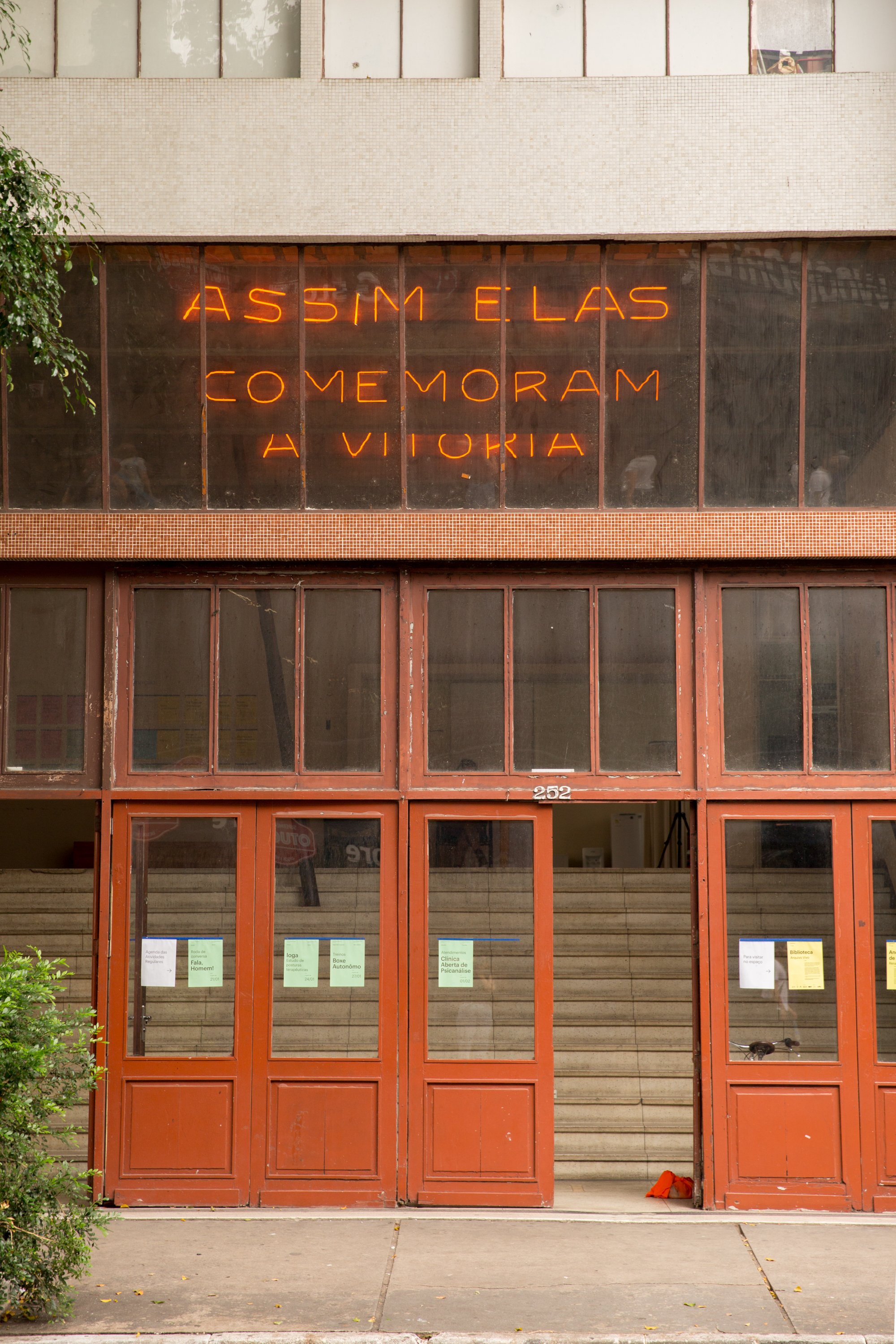
Tactical Dependencies
There’s no such thing as a truly independent space—nor should there be. We want to depend on a context we help create. We want interdependence with other initiatives. In the absence of grand strategies, to build autonomy we need to choose our dependencies carefully.
Casa do Povo runs on a diverse funding model with interconnected income streams: tax incentives, associate members, a friends’ program, voluntary contributions from the initiatives that inhabit the institution, annual fundraising campaigns, public and private grants, partnerships with national and international foundations… Each source is an alliance, shaping what the institution is and what it can do, say, and dream.
By looking carefully at our dependencies, critical thinking can be anchored inside the institution.
Realizable Utopias
Museums, cultural centers, and autonomous spaces can be what architect Yona Friedman called “realizable utopias”: an exercise of the collective imagination, or a full-scale rehearsal for desirable ways of living together.
Yona, who never built permanent buildings, chose instead to defend a mobile architecture—structures that could be assembled and dismantled in response to changing contexts, enabling freedom and resilience through collective consent.
A realizable utopia isn’t measured by global impact but by local transformation. It necessarily starts small: with groups capable of communicating, sharing values, vocabulary, and tools—and living together in daily life.
Interdependence (2022–2025) is a collaboration between e-flux Architecture and OtherNetwork